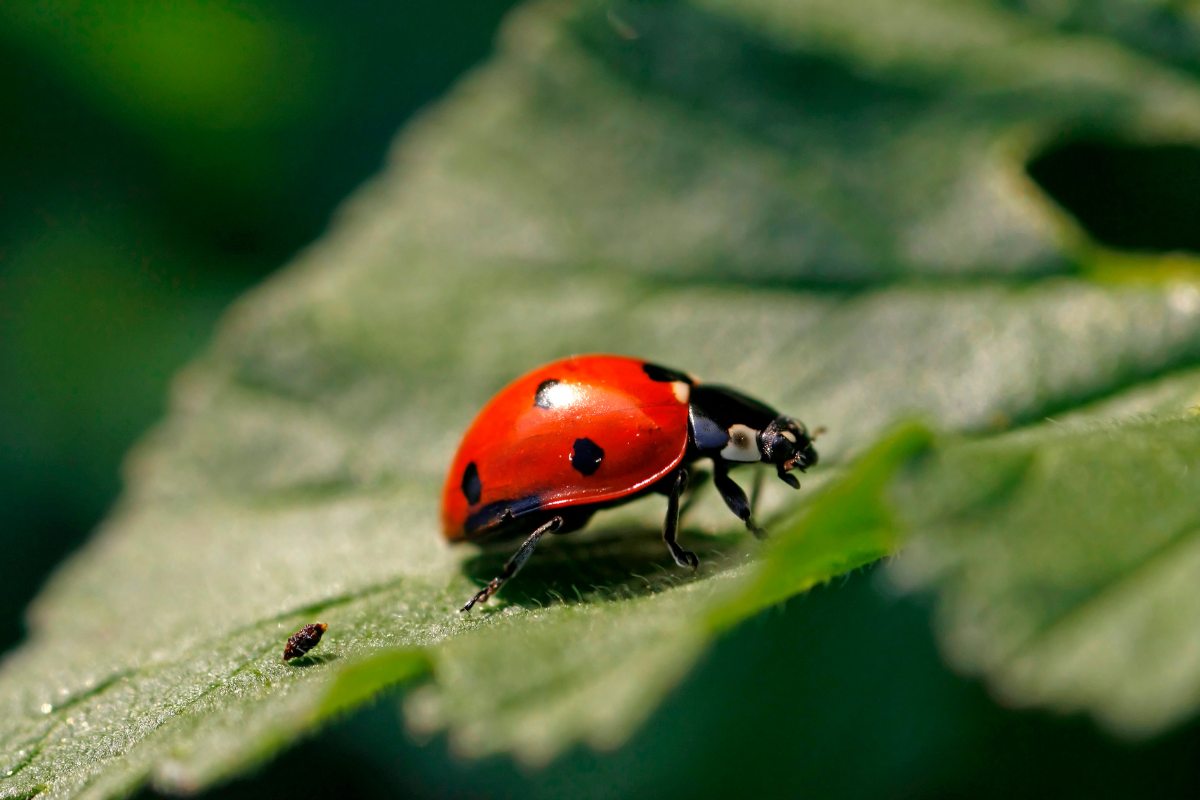By Scott Smith
As spring turns to summer, the garden is bursting with blossoms—and sometimes what seems to be an alarming number of bugs. Relax! Just because you see an insect doesn’t mean you have to reach for the bottle of toxic insecticide. Besides making a shift to organic practices, nature-minded homeowners need to shift their mindset about bugs.
“A lot of people overreact if they see a broccoli leaf chewed up by insects, however the plant is still producing a beautiful head of broccoli. Overreacting to this is more of a problem than the pest itself,” said Scott Meyer, author of Stuff Every Gardener Should Know, in an interview for a Northeast Organic Farming Association video.
Meyer pointed out that 80 percent of bugs are beneficial, and many—like ladybugs, lacewings and praying mantis—are in your garden to eat other insects. Let them do their job and help your organic garden flourish. What’s more, bugs are a critical source of food for all kinds of wildlife, especially for birds at this time of year, as fledglings have hatched and need enormous amounts of food.
Still, there may be times when bug infestations threaten the health of the vegetables and flowers you are trying to grow. That may be the case if you’ve only recently transitioned to organic landscaping practices or, say, have stopped using pesticides but are still dosing your garden with Miracle-Gro. Synthetic fertilizers can effectively sterilize the soil, which throws the natural balance of bugs out of whack. “An organic program done right will take 2 to 5 years to get the soil where it needs to be,” advises Nina Sherwood, a civic leader in Stamford, CT, who in 2021 introduced the most expansive pesticide ban ordinance in the state, which also prohibits the use of synthetic fertilizers. The legislation passed quickly in 2021.
Here are a few tried-and-true organic treatments to use if you’re really bugged out in your garden and running out of patience.
Organic repellants
“Homemade organic gardening sprays work,” says Priscilla Feral, president of Friends of Animals. Her favorite remedy to keep aphids and whiteflies at bay is a hot pepper spray made by mixing two tablespoons of chili sauce and a few drops of biodegradable dish soap in one quart of water. Let it sit overnight and in the morning use a spray bottle to apply to infested plants. (Spraying tender plants with a soapy spray in the middle of the day can cause heat stress.)
Other organic gardeners swear by a basic oil spray. This natural insecticide is made by mixing one cup of vegetable oil with one tablespoon of soap. When ready to apply, mix two teaspoons of the oil spray with a quart of water, shake thoroughly, and spray directly on the surfaces of the plants which are being affected by the pests.
An even simpler way to reduce aphid populations on sturdy plants is to knock off the insects with a strong spray of water, advises Beyond Pesticides. Most dislodged aphids won’t be able to return to the plant, and their honeydew, which attracts ants and other insects, will be washed off as well. Using water sprays early in the day also allows plants to dry off rapidly in the sun and be less susceptible to fungal diseases.
Among commercial organic sprays, the folks at treehugger.com recommend an oil extracted from the seeds of the neem tree. This effective natural insecticide disrupts the life cycle of insects at all stages (adult, larvae, and egg).
“Neem oil acts as a hormone disruptor and as an ‘antifeedant’ for insects that feed on leaves and other plant parts. Neem oil is biodegradable and is nontoxic to pets, birds, fish, and other wildlife, and is effective against a variety of common garden insect pests, as well as being a natural fungicide that can combat powder mildew and other fungal infections on plants.”
Recruit garden allies
Why not call in some natural reinforcements? At Friends of Animals, we’re not too keen on buying ladybugs from the garden center, as the majority of these beloved beneficial insects that are sold are wild harvested in California and the Pacific Northwest, according to Ceres. Instead, invite local ladybugs to your garden by planting alyssum, dill, fennel, marigolds and yarrow. Green Lacewings are also attracted to these same plants and can be a more sustainable store-bought alternative, as they can be purchased as eggs (1,000 eggs are about the size of a pea). Once grown in your garden, lacewings can eat aphids 20 times faster than ladybugs.
Birds may be your best, and certainly most watchable, garden helpers of all. Make them feel welcome by setting up a birdbath in or near your organic garden. They may come just for a drink but end up staying for a whole meal.

